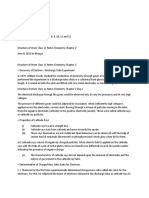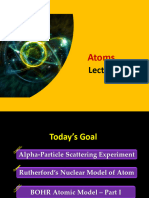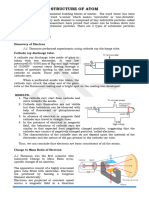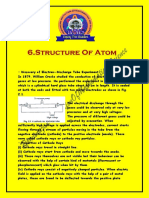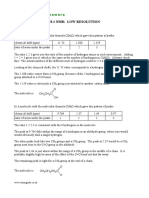0 ratings0% found this document useful (0 votes)
35 viewsChemguide - Answers: The Mass Spectrometer
Chemguide - Answers: The Mass Spectrometer
Uploaded by
Khondokar TarakkyThe document summarizes key aspects of mass spectrometry. It explains that (1) a metal coil releases electrons that knock electrons off sample atoms/molecules, forming positively charged ions; (2) these ions are accelerated by a positively charged ionization chamber and deflected based on their mass/charge ratio; and (3) a detector measures the number of ions hitting it to record currents proportional to ion amounts, revealing the sample's elemental composition.
Copyright:
© All Rights Reserved
Available Formats
Download as PDF, TXT or read online from Scribd
Chemguide - Answers: The Mass Spectrometer
Chemguide - Answers: The Mass Spectrometer
Uploaded by
Khondokar Tarakky0 ratings0% found this document useful (0 votes)
35 views1 pageThe document summarizes key aspects of mass spectrometry. It explains that (1) a metal coil releases electrons that knock electrons off sample atoms/molecules, forming positively charged ions; (2) these ions are accelerated by a positively charged ionization chamber and deflected based on their mass/charge ratio; and (3) a detector measures the number of ions hitting it to record currents proportional to ion amounts, revealing the sample's elemental composition.
Original Description:
MS How it works
Original Title
A Mshowitworks
Copyright
© © All Rights Reserved
Available Formats
PDF, TXT or read online from Scribd
Share this document
Did you find this document useful?
Is this content inappropriate?
The document summarizes key aspects of mass spectrometry. It explains that (1) a metal coil releases electrons that knock electrons off sample atoms/molecules, forming positively charged ions; (2) these ions are accelerated by a positively charged ionization chamber and deflected based on their mass/charge ratio; and (3) a detector measures the number of ions hitting it to record currents proportional to ion amounts, revealing the sample's elemental composition.
Copyright:
© All Rights Reserved
Available Formats
Download as PDF, TXT or read online from Scribd
Download as pdf or txt
0 ratings0% found this document useful (0 votes)
35 views1 pageChemguide - Answers: The Mass Spectrometer
Chemguide - Answers: The Mass Spectrometer
Uploaded by
Khondokar TarakkyThe document summarizes key aspects of mass spectrometry. It explains that (1) a metal coil releases electrons that knock electrons off sample atoms/molecules, forming positively charged ions; (2) these ions are accelerated by a positively charged ionization chamber and deflected based on their mass/charge ratio; and (3) a detector measures the number of ions hitting it to record currents proportional to ion amounts, revealing the sample's elemental composition.
Copyright:
© All Rights Reserved
Available Formats
Download as PDF, TXT or read online from Scribd
Download as pdf or txt
You are on page 1of 1
Chemguide answers
THE MASS SPECTROMETER
1. a) The hot metal coil releases
electrons which are attracted to the
electron trap which is positively
charged. On their way, they hit atoms
or molecules in the sample, and knock
one or more electrons off to give
positive ions.
Those ions are repelled by another
positively charged plate on the left out
of the slit on the right-hand side.
b) The ionisation chamber is held at +10,000 volts. After leaving the chamber, the beam passes
through two more slits, the last of which is at 0 volts. The positive ions are accelerated by repulsion
from the very positively charged ionisation chamber.
c)
(i) Mass and charge. The heavier the ion, the less it is deflected. The higher the positive
charge, the more it is deflected.
(ii) Assuming that all of the ion streams have the same charge, then this must have the
heaviest ions. To be more general about it, the least deflected ion stream will be the one with the
highest mass/charge ratio.
(iii) You would need to increase the magnetic field.
d) To avoid the possibility of the ions hitting, and being deflected by, air molecules.
e) The detector is made of metal connected to a wire. When an ion hits the metal, an electron jumps
off the metal to neutralise the ion. Electrons flow from the wire to replace those removed from the
detector, and this flow is seen as an electric current which can be amplified and recorded. The
greater the number of ions arriving, the greater the current.
2. a) m/z is the mass/charge ratio - the mass of the ion divided by its charge.
b) Zirconium has 5 isotopes with relative isotopic masses of 90, 91, 92, 94 and 96.
The most abundant one is Zr-90, followed by Zr-94 and Zr-92 which have similar abundances.
Then Zr-91, and the least abundant is Zr-96
c) You would find a similar set of peaks but at exactly half the m/z values. The heights of the peaks
are likely to be much less than the corresponding ones with 1+ ions, because a 2+ ion is less likely
to form than a 1+ ion.
www.chemguide.co.uk
You might also like
- The Mass SpectrometerDocument7 pagesThe Mass SpectrometerJosh, LRTNo ratings yet
- Atomic StructureDocument25 pagesAtomic StructureRishika kalambeNo ratings yet
- Structure of Atom Class 11 Notes Chemistry Chapter 2Document21 pagesStructure of Atom Class 11 Notes Chemistry Chapter 2Thariq SNo ratings yet
- Structure of Atom Class 11 Notes Chemistry Chapter 2Document18 pagesStructure of Atom Class 11 Notes Chemistry Chapter 2Jashan Hunjan67% (3)
- Structure of Atom Class 11Document16 pagesStructure of Atom Class 11ssNo ratings yet
- How A Mass Spectrometer WorksDocument32 pagesHow A Mass Spectrometer WorksMadhu Chandra LNo ratings yet
- Structure of Atom Class 11 Notes ChemistryDocument24 pagesStructure of Atom Class 11 Notes Chemistryhelixmanglalina820No ratings yet
- Document of Chapter 2Document17 pagesDocument of Chapter 2EstheruNo ratings yet
- Structure of Atom Class 11 Notes Chemistry Chapter 2Document16 pagesStructure of Atom Class 11 Notes Chemistry Chapter 2M. Muvaffica100% (1)
- 2.3 - How The Mass Spectrometer Works - Chemistry LibreTextsDocument3 pages2.3 - How The Mass Spectrometer Works - Chemistry LibreTextsAhmadulhaqNo ratings yet
- Structure of AtomDocument18 pagesStructure of Atomabishek ImmanuelNo ratings yet
- Periodic Properties - Part 3Document38 pagesPeriodic Properties - Part 3Bhavesh GargNo ratings yet
- Ch-2 Chemistry (Structure of Atom) Class-11Document10 pagesCh-2 Chemistry (Structure of Atom) Class-11kartikaryan9250No ratings yet
- Class XI Structure of AtomsDocument23 pagesClass XI Structure of AtomsSonu JainNo ratings yet
- Mass Spectrometer IIDocument9 pagesMass Spectrometer IIBrooks RalphNo ratings yet
- Grade 11 Ch.2-Structure of AtomDocument20 pagesGrade 11 Ch.2-Structure of Atomkhushiyadav15092000No ratings yet
- XI - Chemistry Study Materials - Class XI - 281022 - 221029 - 203855-16-43Document28 pagesXI - Chemistry Study Materials - Class XI - 281022 - 221029 - 203855-16-43saravanankishore3No ratings yet
- Atoms (4 Lecture)Document172 pagesAtoms (4 Lecture)kumarchandanyadav276No ratings yet
- CBSE Class 11 Chemistry Notes - Structure of AtomDocument15 pagesCBSE Class 11 Chemistry Notes - Structure of AtomPavitar KhatriNo ratings yet
- 11 Chemistry Notes Ch02 Structure of AtomDocument18 pages11 Chemistry Notes Ch02 Structure of AtomSayantanBanerjee0% (1)
- AS Edexcel Chemistry Unit 1 Revision NotesDocument5 pagesAS Edexcel Chemistry Unit 1 Revision NotesTheMagicCarpetNo ratings yet
- Atomic Structure (1-35)Document35 pagesAtomic Structure (1-35)deepakkr08075% (4)
- 2.Structure of AtomDocument44 pages2.Structure of Atomyuvraj123ypnNo ratings yet
- Structure of Atom Class 11 Notes ChemistryDocument18 pagesStructure of Atom Class 11 Notes ChemistryveronicaNo ratings yet
- Chapter 2 - Structure of AtomDocument18 pagesChapter 2 - Structure of AtomstudyforiittomeetbtsNo ratings yet
- Structure of Atom NoteDocument9 pagesStructure of Atom NoteDeep palNo ratings yet
- I Puc - Chemistry - Chapter 2 - Structure of Atom - FM - PRDocument20 pagesI Puc - Chemistry - Chapter 2 - Structure of Atom - FM - PRsrinivasrajesh2007No ratings yet
- (2087) Lecture Notes 1 Atomic Structure eDocument53 pages(2087) Lecture Notes 1 Atomic Structure eRamJiPandeyNo ratings yet
- Chapter - 2 Structure of AtomDocument7 pagesChapter - 2 Structure of AtomViolet IrisNo ratings yet
- Band Theory NotesDocument14 pagesBand Theory NotesjoeNo ratings yet
- Atomic StructureDocument32 pagesAtomic StructureHarshNo ratings yet
- Structure of Atom Class 11 Chemistry CBSE BoardDocument5 pagesStructure of Atom Class 11 Chemistry CBSE BoardminimataNo ratings yet
- 2.STRUCTURE OF ATOMDocument45 pages2.STRUCTURE OF ATOMlalawmpuia2308No ratings yet
- CH - 2 Atomic StructureDocument25 pagesCH - 2 Atomic StructureYASH KUMARNo ratings yet
- Structure of Atom - 404Document72 pagesStructure of Atom - 404vipulvidhya2020No ratings yet
- STRUCTURE OF ATOM at RIMS TS SSCDocument24 pagesSTRUCTURE OF ATOM at RIMS TS SSCSAI PRANEETH REDDY DHADINo ratings yet
- 2.structure of Atom-Smart Booklet-1Document44 pages2.structure of Atom-Smart Booklet-1nadeemnagthan008No ratings yet
- Atomic Structure Theory - EDocument33 pagesAtomic Structure Theory - EthinkiitNo ratings yet
- At ST TheoryDocument54 pagesAt ST TheoryShlok ShelkeNo ratings yet
- Atomic StructureDocument10 pagesAtomic StructureSatyam MittalNo ratings yet
- Structure of AtomDocument27 pagesStructure of AtomEINSTEINNo ratings yet
- 101Chem-Lecture-1,2 (Week 1,2,3) - 231025 - 020549Document38 pages101Chem-Lecture-1,2 (Week 1,2,3) - 231025 - 020549mohammedashry208No ratings yet
- Atomic structureDocument40 pagesAtomic structureinthend1512No ratings yet
- Dual Nature of Radiation & Matter Lect 01 NotesDocument179 pagesDual Nature of Radiation & Matter Lect 01 Notessougatamondal9434No ratings yet
- Lesson 2: Atomic Structure: 25.04.2023 Lets Learn Together! 1Document22 pagesLesson 2: Atomic Structure: 25.04.2023 Lets Learn Together! 1ann wamburaNo ratings yet
- PHS111 CH8PPDocument49 pagesPHS111 CH8PPRenata AlvesNo ratings yet
- Atomic Structure Live Class-1 Teacher NotesDocument21 pagesAtomic Structure Live Class-1 Teacher NotesSHIVAM KUMAR SINGHNo ratings yet
- Structure of Atom (1) NotesDocument19 pagesStructure of Atom (1) NotesAvika SinghNo ratings yet
- LRL Accelerators, The 184-Inch SynchrocyclotronFrom EverandLRL Accelerators, The 184-Inch SynchrocyclotronNo ratings yet
- Electrodynamic Waves: Wireless Transmission Through Air, Metals, Water and the Human BodyFrom EverandElectrodynamic Waves: Wireless Transmission Through Air, Metals, Water and the Human BodyNo ratings yet
- Automotive Electronic Diagnostics (Course 1)From EverandAutomotive Electronic Diagnostics (Course 1)Rating: 5 out of 5 stars5/5 (6)
- Electric Bells and All About Them: A Practical Book for Practical MenFrom EverandElectric Bells and All About Them: A Practical Book for Practical MenNo ratings yet
- Encyclopaedia Britannica, 11th Edition, Volume 6, Slice 8 "Conduction, Electric"From EverandEncyclopaedia Britannica, 11th Edition, Volume 6, Slice 8 "Conduction, Electric"No ratings yet
- Hybridization TarakkyDocument36 pagesHybridization TarakkyKhondokar TarakkyNo ratings yet
- Writing Ionic FormulaeDocument6 pagesWriting Ionic FormulaeKhondokar TarakkyNo ratings yet
- Chapter 1 Kinetic Theory and DiffusionDocument4 pagesChapter 1 Kinetic Theory and DiffusionKhondokar TarakkyNo ratings yet
- U04 Notes Part4 Intermolecular ForcesDocument66 pagesU04 Notes Part4 Intermolecular ForcesKhondokar TarakkyNo ratings yet
- 9701 m17 QP 12Document16 pages9701 m17 QP 12Khondokar TarakkyNo ratings yet
- Naming WorksheetsDocument9 pagesNaming WorksheetsKhondokar TarakkyNo ratings yet
- H-1 NMR: Introduction: Kms TarakkyDocument2 pagesH-1 NMR: Introduction: Kms TarakkyKhondokar TarakkyNo ratings yet
- Q MsmplusDocument1 pageQ MsmplusKhondokar TarakkyNo ratings yet
- Drying Agent and Dehydrating AgentDocument1 pageDrying Agent and Dehydrating AgentKhondokar TarakkyNo ratings yet
- Answer All The Questions in This Section in The Spaces Provided. The Total Mark For This Section Is 45Document20 pagesAnswer All The Questions in This Section in The Spaces Provided. The Total Mark For This Section Is 45Khondokar TarakkyNo ratings yet
- Naming WorksheetsDocument9 pagesNaming WorksheetsKhondokar TarakkyNo ratings yet
- H-1 NMR: Low Resolution: Chemical ShiftsDocument1 pageH-1 NMR: Low Resolution: Chemical ShiftsKhondokar TarakkyNo ratings yet
- Q NmrH1highresDocument5 pagesQ NmrH1highresKhondokar TarakkyNo ratings yet
- Mass Spectra of Elements: Kms TarakkyDocument1 pageMass Spectra of Elements: Kms TarakkyKhondokar TarakkyNo ratings yet
- Fragmentation Patterns: Kms TarakkyDocument2 pagesFragmentation Patterns: Kms TarakkyKhondokar TarakkyNo ratings yet
- Chemguide - Answers: H-1 NMR: High ResolutionDocument2 pagesChemguide - Answers: H-1 NMR: High ResolutionKhondokar TarakkyNo ratings yet
- Chemguide - Answers: H-1 NMR: Low ResolutionDocument2 pagesChemguide - Answers: H-1 NMR: Low ResolutionKhondokar TarakkyNo ratings yet
- Finding Orders of Reaction Experimentally: Chemguide - AnswersDocument2 pagesFinding Orders of Reaction Experimentally: Chemguide - AnswersKhondokar TarakkyNo ratings yet
- The Mass Spectrometer: Kms TarakkyDocument2 pagesThe Mass Spectrometer: Kms TarakkyKhondokar TarakkyNo ratings yet
- Chemguide - Answers: Mass Spectra of ElementsDocument1 pageChemguide - Answers: Mass Spectra of ElementsKhondokar TarakkyNo ratings yet
- Chemguide - Answers: H-1 NMR: IntroductionDocument2 pagesChemguide - Answers: H-1 NMR: IntroductionKhondokar TarakkyNo ratings yet
- Bangladesh Studies: History and Culture of BangladeshDocument5 pagesBangladesh Studies: History and Culture of BangladeshKhondokar TarakkyNo ratings yet
- Chemguide - Answers: Mass Spectra: The M+ LineDocument1 pageChemguide - Answers: Mass Spectra: The M+ LineKhondokar TarakkyNo ratings yet
- Chemguide - Answers: Fragmentation PatternsDocument2 pagesChemguide - Answers: Fragmentation PatternsKhondokar TarakkyNo ratings yet
- Test For GR 9Document3 pagesTest For GR 9Khondokar TarakkyNo ratings yet







